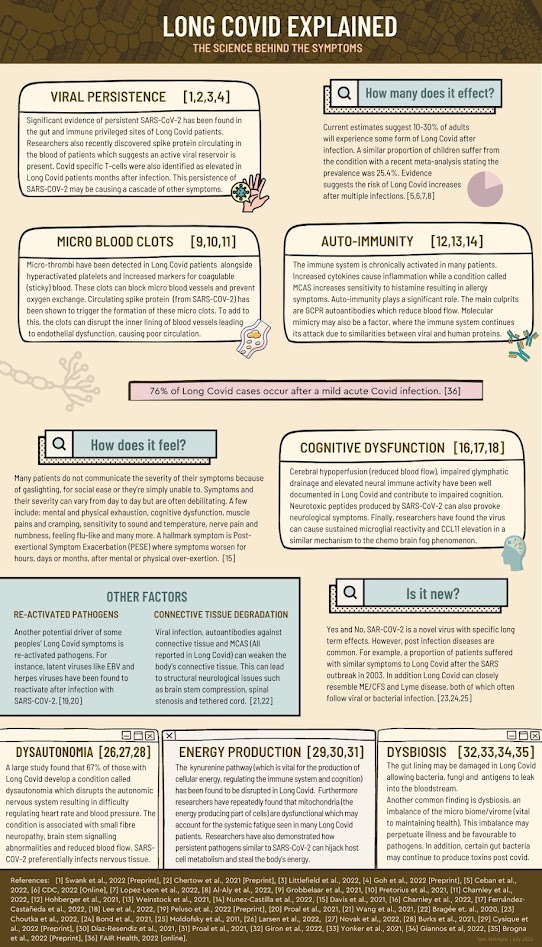Long-COVID Chest Pain: Main Causes, Ways to Relieve (2023)
Long COVID, or post-COVID conditions, are evolving terms, and as time passes, we’re learning more about the aftereffects of COVID-19 infection. One of the most common symptoms that have been observed is chest pain, which affects up to 22 percent of patients two months after acute infection.
“It’s very common with patients that experienced significant cough during their COVID infection, but can also be a sign of something more troubling,” Dr. Thomas Gut, medical director of the Post-COVID Recovery Center at Staten Island University Hospital, part of Northwell Health in New York, told The Epoch Times.
While this can be frightening for COVID survivors, it doesn’t always mean you’re experiencing a life-threatening condition.
Post-COVID Chest Pain Cause 1: Heart Disease and Blood Clotting
“COVID has been associated with heart disease and also abnormal blood clots,” observed Gut.
These can cause chest pain.
A large study found (Circulation. 2022) COVID-19 was linked to a severely increased risk of blood clot-related issues immediately after diagnosis compared to people never infected. This includes heart attack and stroke. Researchers also found that this risk remained higher for up to 49 weeks, although dropped sharply by the second week.
The study shows that if someone had COVID-19, “then they should be talking with their physicians about managing their cardiovascular risk, which is likely to be increased for some level of time,” study senior author Jonathan Sterne, a professor of medical statistics and epidemiology at England’s University of Bristol, said in a statement.
The U.S. Centers for Disease Control and Prevention report that COVID-19 survivors have twice the risk of developing pulmonary embolism (blood clot in the lungs) or respiratory conditions.
Chest pain after COVID-19 could also be related to pericarditis (inflammation of the lining of the heart), and coronary artery disease (low blood flow to the heart), according to Dr. Luis Ostrosky-Zeichner, division chief of Infectious Diseases and Epidemiology at UTHealth Houston and Memorial Hermann.
Pericarditis is often mild and goes away on its own. However, if not treated, some cases can become chronic and seriously affect your heart. While it can take weeks or months to recover, full recovery is most likely with rest and ongoing care, which can also reduce the risk of getting it again.
Post-COVID Chest Pain Cause 2: Inflammation of the Lung
COVID-19 can cause lung complications such as pneumonia and, in the most severe cases, acute respiratory distress syndrome (ARDS).
Newer coronavirus variants might also cause airway disease, like bronchitis, potentially severe enough for hospitalization.
These conditions can create inflammation in the chest severe enough to cause pain.
In those with COVID pneumonia, “the chest pain can come from direct inflammation of the lung lining, called the pleura,” said Dr. Jacob Teitelbaum, a board-certified internist and nationally known expert in the fields of chronic fatigue syndrome, fibromyalgia, sleep, and pain. “[The pain will] tend to get worse with deep breaths.”
This kind of chest pain can resolve with time (months) and anti-inflammatory treatments such as highly absorbable forms of curcumin or ibuprofen, he added.
It Can Be Benign Muscle Pain, One Way to Check
But the chest pain “usually will be benign,” said Teitelbaum.
Those younger than the typical age for increased heart attack risk can look for specific signs that the pain isn’t life-threatening.
For people under 50 years of age, where the pain: is worse upon taking a deep breath, changing position or pushing over the area; does not trigger sweats or left arm pain; isn’t worse with exertion; isn’t associated with coughing up blood or yellow mucus; and doesn’t go away with an antacid, it’s most often just going to be benign muscle pain in your chest-wall area, said Teitelbaum.
If chest pain goes away with an antacid, especially if the pain is worse while lying down or with burping, it’s most often going to be indigestion and acid reflux.
“Do not use PPI acid blockers, as these are toxic and can worsen COVID in general,” Teitelbaum advised. “Instead, use famotidine, which helps the body heal from COVID by improving immunity, or [use] chewable antacids.”
There is a simple way to check whether it’s just pain in your chest muscles.
Push over the area of pain with your fingertips using about five pounds of pressure, which is enough to make your fingernail bed turn white.
If you can “reproduce the pain” by pressing over a bony area, like the ribs, Teitelbaum said, it is most likely a benign muscle pain. The rib cage is like a suit of armor around our internal organs, and pushing on the outside will not make the heart or lung underneath it hurt.
But after having chest pain post-COVID, the first thing you should do is see your doctor immediately to make sure it’s not anything dangerous.
“With chest pain, better safe than sorry,” Teitelbaum said. Essentially, your doctor is ruling out that you are having an acute heart attack, angina, or serious lung issue. “Heart attacks can kill if treatment is delayed.”
As long as a doctor has determined your symptoms are not worrisome, then just using a heating pad and topical comfrey or other creams like Icy Hot (topical aspirin and menthol) can be helpful, advised Teitelbaum.
About the Author: George Citroner reports on health and medicine, covering topics that include cancer, infectious diseases, and neurodegenerative conditions. He was awarded the Media Orthopaedic Reporting Excellence (MORE) award in 2020 for a story on osteoporosis risk in men.


.png)






Comments